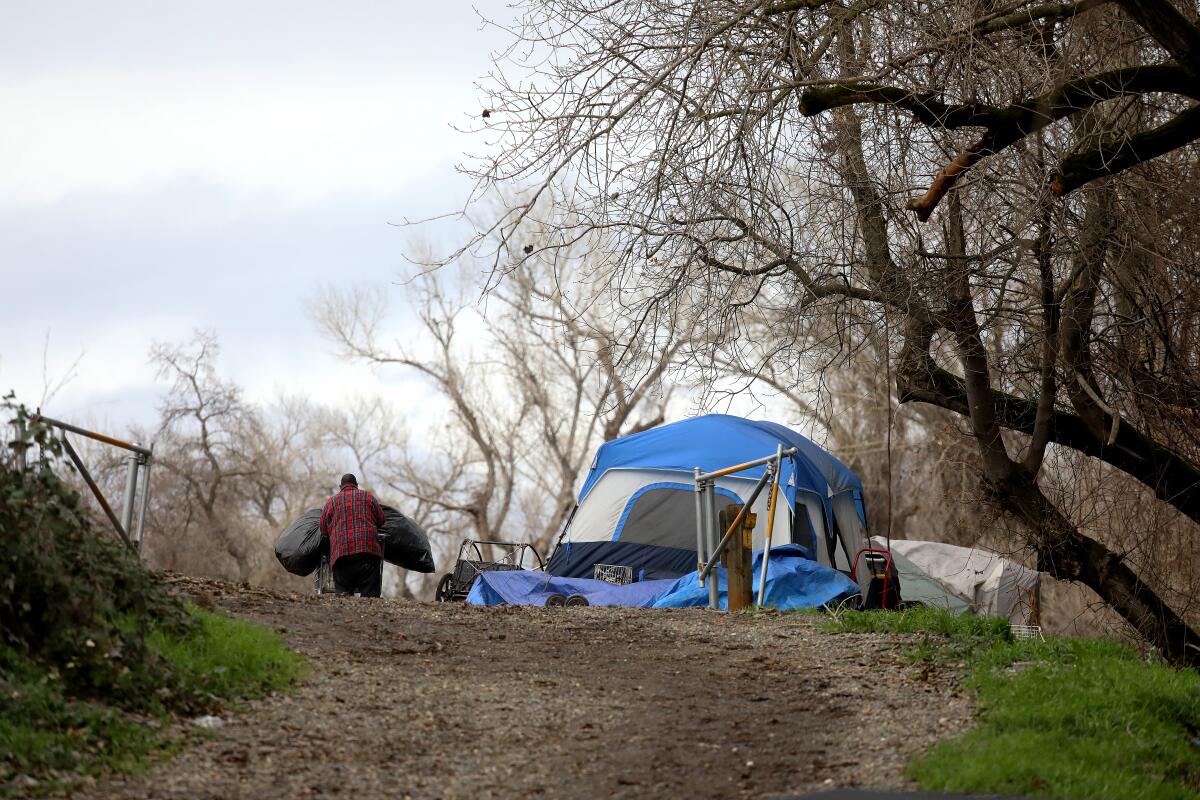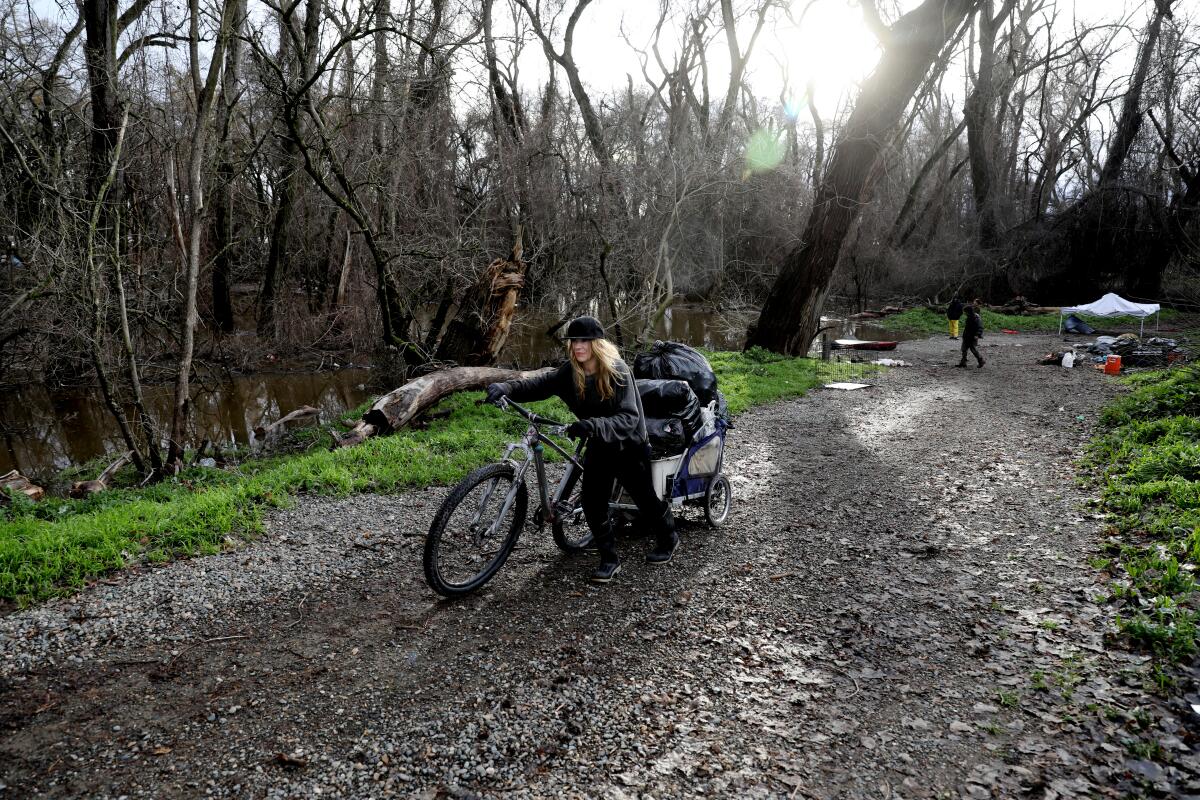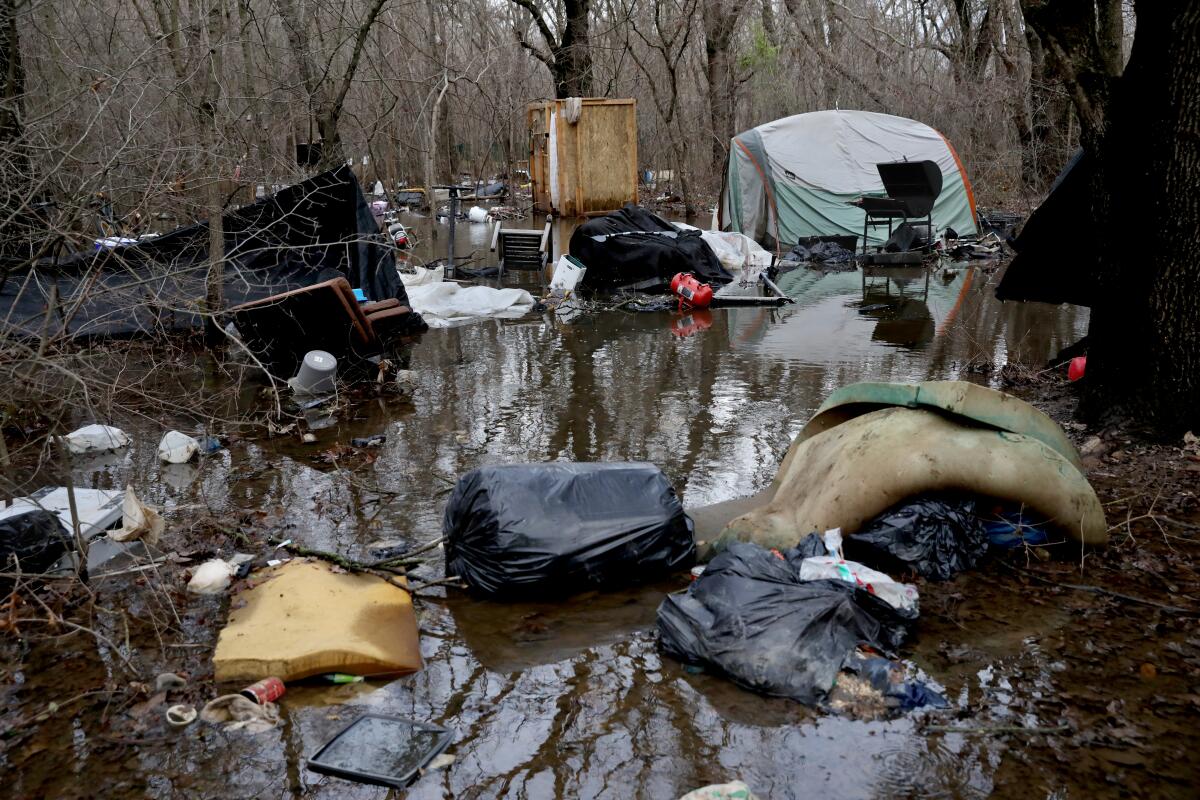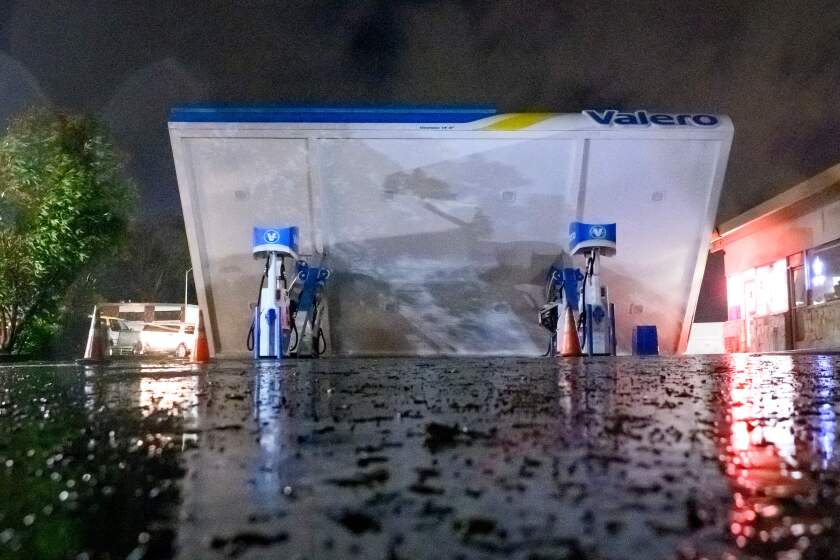Massive storm poses lethal danger for homeless people. California is scrambling to help

- Share via
SACRAMENTO — Ahead of a massive storm expected to drench an already sodden state, officials throughout California are rushing to bring some of the tens of thousands of people living on streets and along waterways into shelters.
In Sacramento, which is still recovering from flooding caused by a brutal New Year’s Eve storm, city officials have launched an extensive effort to convince unhoused people along the American River to relocate to safer ground.
The storm hit late Wednesday afternoon and was expected to continue into Thursday. Two to 4 inches of rain are expected in some metro areas, with 4 to 8 inches in some mountain areas. The National Weather Service has warned of “widespread flooding and damaging winds.”
But as clouds gathered Wednesday afternoon over Sacramento — marking an end to a brief respite between deluges — some said they had no plans to move.

Mark, who is 58 and declined to give his last name, said he had spent several days trying to weatherize his camp, located next to a levee along the American River.
“It’ll hold up,” he predicted, adding that he wasn’t worried about rising river water because he believed he was on high enough ground.
Mark had come to Sacramento’s Friendship Park, a homeless services operation run by Loaves and Fishes, for a hot meal Wednesday before the rain began in earnest.
The park was bustling Wednesday with unhoused people getting ready for the storm. Many were gathering supplies, including clear plastic ponchos from Loaves and Fishes.
When will California storms hit hardest and how long will they last?
After finishing, Mark climbed onto his bike and headed home. He wanted to get back to his dog before the rain, he said.
Donald Miller, 47, who occupies the camp next to Mark, sounded slightly less sanguine about the weather. His sleeping bags, he complained, were soaked in the last storm.
Still, Miller said he would stay put too. His dog had just had puppies.
Fire officials and park rangers have been patrolling the American River and American River Parkway, a 23-mile park with hundreds of unhoused residents, to warn them of the storms and offer shelter. A helicopter was also deployed to warn people to seek higher ground.

On Bannon Island, which is cut off from the mainland during major storms, some unhoused people turned down emergency shelters and opted to stay where they were, using boats to get around, county officials said.
“They’re not strangers to the situation and are pretty familiar with watching the river increase and moving up the higher ground,” said Janna Haynes, a spokeswoman for Sacramento County, adding that there had been no water rescues yet.
Two shelters operated by the city and county, each with about 50 beds, have taken in some unhoused people, and a third shelter is ready to open, she said.
Trent, 53, who declined to give his last name, has been unhoused for more than a year in Sacramento County and braved the deadly storm last weekend in his car. After asking around, he found out about an evacuation shelter set up at the Barbara Morse Wackford Community Center in Elk Grove and arrived Wednesday morning.
“The wind and the way that is, you’ve got to worry about stuff coming into your car,” he said that night. “Downed trees, you know, and debris. That’s the biggest worry.”
Years ago, Trent was on the streets for a few weeks without his car, and he said the fact that he was able to find an umbrella saved his life.
“Like anything else, even if you go camping, once you get wet, that becomes a health problem,” he said. “Once you get your stuff wet, then it’s just a matter of time before you [get] sick if you can’t get dry.”
The intense downpours — coming after an earlier deluge days ago — pushed some rivers toward flood stage, prompting a string of evacuations from towns along the Russian River to communities in Santa Cruz County and beyond.
About 10 out of 30 beds at the center were filled as of Wednesday afternoon, split between people who were evacuated from their homes and unsheltered people, said Debbie Imlay, a spokesperson for the Red Cross.
“We’re expecting an increase tonight, especially because of the winds,” she said. “I think the biggest concern is here in Sacramento, the City of Trees, trees are falling over. We’re not talking small trees; we’re talking 100-year-old trees that have huge roots. We’re extremely worried about losing power.”
In San Francisco, beds are available through Jan. 15 on a first-come, first-served basis at four existing shelters, according to the city Department of Homelessness and Supportive Housing.
The city has also set up an emergency pop-up shelter at the County Fair Building.
A homeless outreach team was on the streets talking with unhoused people, providing them information on where to find shelter and passing out beanies, ponchos, blankets and other necessities, Shireen McSpadden, Department of Homelessness and Supportive Housing executive director, said during a news briefing on Tuesday.
Jamel Davis’ plan to stick it out through the bad weather included propping up his tent in the Tenderloin on some wooden pallets, padding the inside with comforters and “praying.”
Davis, 38, said he’s endured many storms during his years of being on the streets in San Francisco and planned to just “ride this baby out.”
“I feel like it’s going to be all right,” he said as the wind picked up and rippled the blue tarp covering his tent.

On Tuesday night, the city of San Jose issued a mandatory evacuation order for unhoused people living in creek areas.
“If you are in the banks of the waterway, your life is in danger,” the San Jose Police Department wrote on Twitter.
More than 5,000 unsheltered people live in San Jose, with a substantial number near waterways, according to Mayor Matt Mahan.
Mahan canvassed Coyote Creek with the city’s homeless outreach team Wednesday, warning people about the risk of rapidly rising water.
The city has opened three overnight warming shelters with a total of 230 beds, separate from the traditional shelters that operate year-round, according to Mahan.
“We know living outside can be very dangerous — it leads to premature death,” Mahan said. “When we have severe weather like an atmospheric river, the risk grows significantly.”
A massive storm heads for Southern California, with high winds and flooding expected for the region, as Los Angeles County issues evacuation warnings for some.
Southern California was similarly preparing for the storm on Wednesday.
In Ontario, officials have been reaching out to people living along the city’s three washes and offering them vouchers for hotel rooms, said Ontario Fire Department Battalion Chief Bobby Johnson.
During a storm in November, multiple people in Ontario were swept out from the West Cucamonga Channel, which flows into a nearby catch basin. Five were rescued and three died in the floodwaters.
In Los Angeles County, a small team of sheriff’s deputies has been routinely visiting dozens of riverbeds, creeks and channels to warn unhoused people about storms and flooding, said Lt. William Kitchin of the Sheriff’s Homeless Outreach Services Team.

Because there has been so little rain in recent years, they need to be reminded of the dangers of living in riverbeds, where the water can rise extremely fast during storms, Kitchin said.
Ahmad Chapman, a spokesman for the Los Angeles Homeless Services Authority, said that in advance of major storms, outreach workers head to rivers and other flood-prone areas telling people to evacuate and prioritizing them for interim housing.
In Orange County, there are no emergency cold weather shelters for homeless people, though the county and some cities run longer-term shelters.
A county spokeswoman did not immediately return requests for comment.
“It is cold and wet, and there is nowhere to walk in for help or even to get warm for a few hours in all of Orange County,” said Brooke Weitzman, an attorney who co-founded the Elder Law and Disability Rights Center in Santa Ana.
Around 4 p.m. Wednesday, some Orange County residents received a public safety alert on their phones, warning them to leave the Santa Ana River area, where homeless people often camp.
Times staff writers Gabriel San Román and Hannah Fry contributed to this report.
More to Read
Sign up for Essential California
The most important California stories and recommendations in your inbox every morning.
You may occasionally receive promotional content from the Los Angeles Times.

















